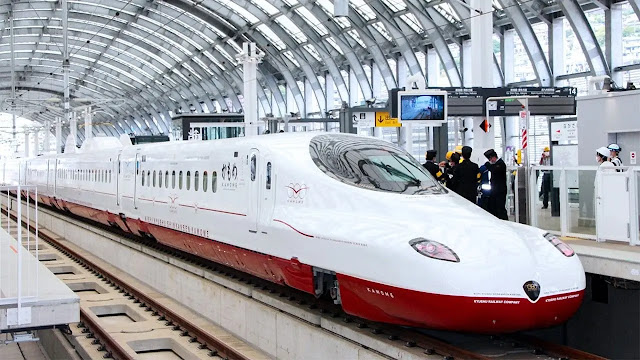A bullet train is used to portray a fast traveler rail train. Beginning in Japan, it is so named due to its smooth, streamlined appearance and its speed. The actual Japanese word for this rail administration is Shinkansen, which, when in a real sense converted into English, signifies "new trunk lines."
Public transportation is a significant component of Japanese society, as the geology of the island country restricts how much accessible and usable space for streets. For some individuals, mass transportation is their primary method of transportation. Considering this reality, the bullet train was imagined as a high-velocity rail route that would decrease the movement time between Japan's substantial urban communities.
The train accomplishes its fast using a streamlined shape and innovation intended to expand the force of the train completely. The railroad tracks for it were grown explicitly for rapid rail administration. Regular trains don't run on the Shinkansen lines and rapid trains don't run on customary ways. This permits the trains to run at reliably high velocities, without diminishing their working paces for more slow trains on the tracks.
The bullet train started administration in Japan in late 1964, associating with the urban communities of Tokyo and Osaka. The first trains went at around 125 miles each hour (200 kilometers each hour.) This permitted the 320-mile (550 kilometers) distance between Tokyo and Osaka to be gone in around three hours.
The progress of Japan's excellent-speed rail line urged different countries to foster their comparative projects. Rapid rail is presently an installation of mass transportation in numerous European and Asian countries. Two of the more prominent administrations are in France and Spain.
The French Train à Grande Vitesse (TGV) line is broadly viewed as the broadest fast rail framework in Europe. The TGV started administration in 1981 between the urban communities of Paris and Lyon. By 2007, the line had more than 200 objections all through France and in adjoining nations like Germany, Switzerland, and Luxembourg. It is assessed that starting around 2009, the framework has conveyed an overabundance of 1.3 billion travelers since the administration started.
The first bullet train in India is supposed to run between Surat and Bilimora. The venture expects to run a bullet train at 320 kmph along a high-velocity rail (HSR) track between Ahmedabad and Mumbai, covering a distance of 508 km and halting at 12 stations. The rail line is expected to cut the ongoing six-hour venture between the two urban communities fifty, to about three hours. 81% of the venture's assessed 1.1 lakh crore cost is being supported by the Japan Worldwide Collaboration Organization (JICA).
The bullet train will be functional in 2026 and the cycle to accomplish the objective is in progress. Aside from this, he said that an arrangement is in progress to change over 199 rail route stations in the nation over into elite ones, following the Habibganj model. Ahmedabad railroad station will likewise be made elite.
The preliminaries of the bullet train will be directed at a speed of 350 kilometers each hour, which is equivalent to the take-off speed of planes. The functional speed will be 320 kmph. The main preliminary is supposed to be held among Bilimora and Surat in Gujarat in 2026.
Before April, the authorities said Japan will at first send six fast Shinkansen trains which will be changed for Indian circumstances like temperature, residue, and weight. The mentors will be acquired by knockdown circumstances and will be collected here in India.
India will get the E5 Shinkansen series trains presently working in Japan. Be that as it may, the Public Fast Rail Company Limite is directing examinations to redesign them to Indian circumstances as far as residue and temperature, the NHSRCL said
The E5 series is a Japanese Shinkansen high-velocity train type worked by Hitachi and Kawasaki Weighty Enterprises. They are fit for running at a speed of 320 kmph and are 3.35 m wide, the vastest among such trains are accessible in nations like France and Germany.
The trains will run on the "piece track framework", an extraordinary track, famously known as HSR innovation for the development of tracks, protected by the Japanese.
It is relevant to specify here that the Mumbai-Ahmedabad high-velocity rail (MAHSR) passage will incorporate 12 stations. They are Surat, Anand, Vadodara, Ahmedabad, Bilimora, Sabarmati, Bharuch, Mumbai, Thane, Virar, Boisar, and Vapi. MAHSR will be the nation's most memorable fast rail line when finished.







0 Comments